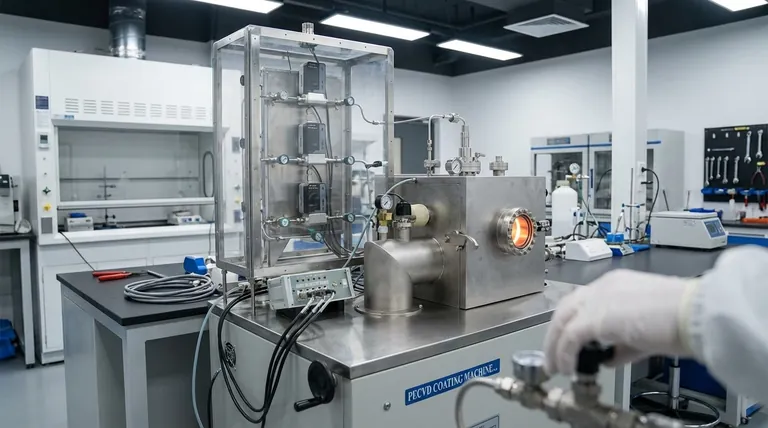At its core, Chemical Vapor Deposition (CVD) is a sophisticated process for creating high-performance, ultra-thin coatings. It involves placing a component, known as the substrate, into a reaction chamber and introducing specific gases. These gases react on the hot surface of the substrate, decomposing to form a solid, durable film that chemically bonds to the material, fundamentally altering its surface properties.
The crucial insight is that CVD is not merely applying a layer; it is chemically growing a new surface. This distinction from physical application methods is what gives CVD its unique ability to create highly uniform and adherent coatings, even on complex shapes.

How the CVD Process Works
CVD is a carefully controlled chemical process that builds a film layer by layer. The quality of the final coating depends on precise management of several key variables.
The Core Components
The process begins by placing the object to be coated (the substrate) inside a sealed reaction chamber, often under a vacuum. Gaseous molecules containing the required coating elements, known as precursor gases, are then introduced into the chamber.
The Role of Energy
Energy, typically in the form of high heat, is applied to the substrate. This energy breaks down the precursor gases on the substrate's surface, triggering a chemical reaction. The atoms are deposited, forming a stable and dense film that becomes an integral part of the component.
An Advanced Variation: PECVD
A notable variation is Plasma-Enhanced Chemical Vapor Deposition (PECVD). Instead of relying solely on high heat, PECVD uses an energized plasma to drive the chemical reaction. This allows the process to run at much lower temperatures, making it suitable for coating heat-sensitive materials like semiconductors and certain polymers.
The Critical Distinction: CVD vs. PVD
While often discussed together, Chemical Vapor Deposition (CVD) and Physical Vapor Deposition (PVD) are fundamentally different processes. Understanding this difference is key to choosing the right technology.
The CVD Method: A Chemical Reaction
In CVD, the coating is formed by a chemical reaction directly on the substrate's surface. Because the precursor gases can flow around the entire component, CVD provides exceptionally conformal coatings. This means it can uniformly cover intricate, complex geometries and internal surfaces.
The PVD Method: A Physical Transfer
In contrast, PVD is a physical, line-of-sight process. A solid source material is vaporized (by sputtering or evaporation) and the vapor travels in a straight line to coat the substrate. This makes it difficult to evenly coat complex shapes, as surfaces not in the direct "line of sight" of the source receive little to no coating material.
Understanding the Trade-offs
Neither method is universally superior; the choice depends entirely on the application's specific demands.
When to Prefer CVD
CVD's primary advantage is its ability to create highly uniform (conformal) coatings on parts with complex geometries. If you need to coat the inside of a tube or a component with intricate features, CVD is often the superior choice. The resulting film is also chemically bonded to the substrate, leading to excellent adhesion.
Limitations and PVD's Advantages
The high temperatures required for traditional CVD can damage or warp certain substrate materials. While PECVD mitigates this, PVD generally operates at lower temperatures. Furthermore, the precursor gases used in CVD can be toxic or corrosive, requiring stringent safety protocols. PVD often offers a wider variety of coating materials, including pure metals, alloys, and certain ceramics.
Making the Right Choice for Your Goal
Selecting the right deposition technology requires a clear understanding of your project's primary objective.
- If your primary focus is coating a complex shape uniformly: CVD is the superior technology due to its non-line-of-sight, conformal deposition process.
- If your primary focus is coating a heat-sensitive material: PVD or a low-temperature variant like PECVD are your best options, as they avoid the high heat of traditional CVD.
- If your primary focus is achieving specific chemical properties or high purity: CVD excels in creating highly pure films, such as those required for anti-reflective coatings and in the semiconductor industry.
- If your primary focus is process simplicity and material variety: PVD is often considered a more straightforward process with a very broad palette of available coating materials.
Ultimately, choosing a coating technology is about matching the process capabilities to your specific performance requirements.
Summary Table:
| Feature | CVD | PVD |
|---|---|---|
| Process Type | Chemical Reaction | Physical Transfer |
| Coating Uniformity | Excellent (Conformal) | Line-of-Sight |
| Typical Temperature | High (Lower with PECVD) | Lower |
| Best For | Complex shapes, internal surfaces | Simpler geometries, heat-sensitive substrates |
Need a high-performance coating for a complex component?
At KINTEK, we specialize in advanced lab equipment and consumables for precise coating applications. Our expertise in technologies like CVD can help you achieve uniform, durable films that enhance the performance and lifespan of your parts.
Let's discuss your project requirements and find the optimal coating solution for you. Contact our experts today to get started!
Visual Guide

Related Products
- Inclined Rotary Plasma Enhanced Chemical Vapor Deposition PECVD Equipment Tube Furnace Machine
- HFCVD Machine System Equipment for Drawing Die Nano-Diamond Coating
- 915MHz MPCVD Diamond Machine Microwave Plasma Chemical Vapor Deposition System Reactor
- Vacuum Hot Press Furnace Machine for Lamination and Heating
- 1200℃ Split Tube Furnace with Quartz Tube Laboratory Tubular Furnace
People Also Ask
- What is PECVD used for? Achieve Low-Temperature, High-Performance Thin Films
- What is the difference between CVD and PECVD? Choose the Right Thin-Film Deposition Method
- What is PECVD silicon deposition? Achieve Low-Temperature, High-Quality Thin Films
- What is the difference between PECVD and CVD? Unlock the Right Thin-Film Deposition Method
- What is meant by vapor deposition? A Guide to Atomic-Level Coating Technology



















